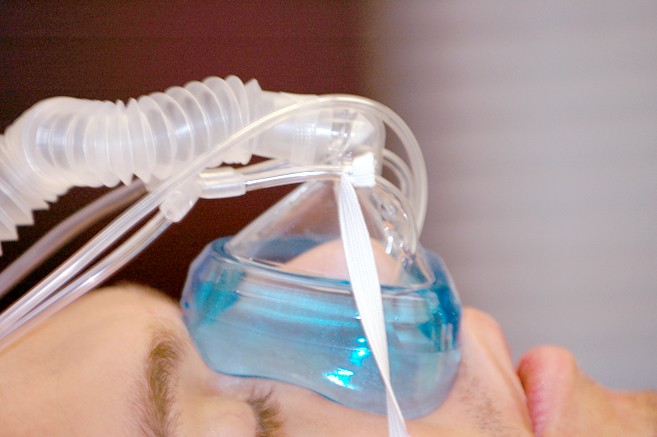
Researchers discovered that a single one-hour treatment involving breathing a mixture of oxygen and nitrous oxide can improve symptoms in patients with hard-to-treat depression.
By Theresa Ahearn
According to a new study published in the journal of Science Translational Medicine, nitrous oxide may offer new hope for those living with depression symptoms. Researchers from Washington University School of Medicine in St. Louis and the University of Chicago discovered in a Phase 2 clinical trial that symptoms of treatment-resistant depression improved in patients treated with nitrous oxide and oxygen. The findings provided promising evidence that nitrous oxide, when mixed with oxygen, had early antidepressant effects, even in patients with a history of severe, or treatment-resistant depression (Nagele et al., 2021).
Research Using Nitrous Oxide to Treat Depression
One-third of those diagnosed with depression are in danger of developing treatment-resistant depression (TRD), a type of depression where standard medications provide little or no relief in symptoms. The study’s senior investigator and professor of psychiatry at Washington University, Dr. Charles R. Conway, stated in a press release that a large percentage of patients don't respond to standard antidepressant therapies. He continued that the patients involved in this study had previously failed, on average, 4.5 antidepressant trials, and that it's very important to find therapies to help these patients.
For the past decade, Conway has been researching the use of nitrous gas as an antidepressant. Typically, standard antidepressants work by blocking norepinephrine and serotonin receptors in the brain, but they can take weeks to work. However, nitrous oxide interacts with NMDA glutamate receptors, which improves symptoms within a few hours. A previous proof-of-principle study in 2018 demonstrated that inhaling nitrous oxide produced immediate antidepressant effects for individuals with treatment-resistant depression, but its effectiveness after 24 hours was not known (Nagele, Zorumski & Conway, 2018).
Positive Results with Nitrous Oxide

For the most recent trial, the researchers treated 24 patients. Each subject was given three treatments, one month apart. Research administered a mixture of 50% nitrous oxide and 50% oxygen for the first treatment, and a mixture of 25% nitrous oxide and 75% oxygen for the second treatment. The third treatment was a placebo. After breathing a nitrous oxide solution for one hour, 55% of the 20 people who completed all of the study's treatments and follow-up exams reported a significant improvement in half of their depressive symptoms, and 40 were considered to be in remission, and no longer clinically depressed. Over the course of the trial, 85% of those who got levels of nitrous oxide and the placebo treatment saw a significant enough improvement in their clinical categorization to report symptoms improved from severe to moderate depression (Nagele et al., 2021).
In the latter study, researchers discovered that one inhalation session with higher doses of nitrous oxide gas helped to alleviate the symptoms of treatment-resistant depression. Though, the new study discovered that when given just half the previous dose, laughing gas was just as effective at relieving depression. The key difference between a lower dosage and the higher dosage was the duration of the antidepressant effects. The researchers believe nitrous oxide may improve depression symptoms because the gas shares properties with the more commonly known dissociative anesthetic, ketamine which interacts with NMDA glutamate receptors (Nagele et al., 2021). The instant antidepressant efficacy of ketamine prompted researchers to look for other medicines that work in a similar way.
Advantages of Nitrous Oxide
Though ketamine has recently shown promise in improving treatment-resistant depression, Conway and Nagele believe nitrous oxide may have some advantages, especially when comparing short and long-term side effects. In a dentist office for example, if a patient is given nitrous oxide during a procedure, its anesthetic effects subside very quickly. Conway stated in comparison, ketamine requires the patient to be monitored for up to two hours after a procedure, as well as require the patient be driven home by someone else. Ketamine, also has the potential to cause long-term health problems such as memory loss and psychosis. When prescribed by a doctor, nitrous oxide is relatively safe and inexpensive.
The Future of Nitrous Oxide in Treating Depression
Nagele and Conway hope their findings will influence scientists to conduct a larger, multi-center study that would compare the effects of ketamine and nitrous oxide in a placebo-controlled study. Though there are limited studies looking at the effect of nitrous oxide on depression and other mood disorders, Dr. Conway’s trial is a promising step toward providing more effective treatments for those suffering from depression.
Author: Theresa Ahearn is a freelance writer, currently residing in Oak Ridge, Tennessee. She received her Bachelor of Arts from the New York Institute of Technology and Master of Science from Central Connecticut State University. When not writing she can be found fishing or traveling someplace new.




